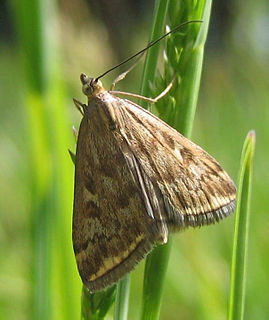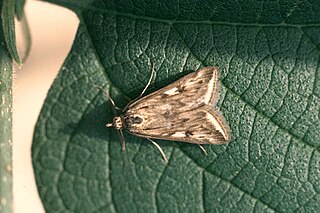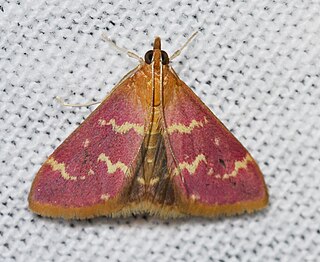
The nutmeg, also known as the clover cutworm, is a moth of the family Noctuidae.

Loxostege sticticalis is a species of moth of the family Crambidae. It was first described by Carl Linnaeus in 1761 and is found in the Palearctic and Nearctic realms.

Nomophila noctuella, the rush veneer, is a species of moth of the family Crambidae.

Colias philodice, the common sulphur or clouded sulphur, is a North American butterfly in the family Pieridae, subfamily Coliadinae.

Leptarctia is a monotypic tiger moth genus in the family Erebidae described by Stretch in 1872. Its only species, Leptarctia californiae, was described by Francis Walker in 1855. It is found in western North America, from New Mexico and Colorado to California and north to British Columbia. The habitat consists of open forests, meadows and clearings in the mountains.

Loxostege is a genus of moths of the family Crambidae.

Autographa californica, the alfalfa looper, is a moth of the family Noctuidae. The species was first described by Adolph Speyer in 1875. It is found in western North America from southern British Columbia to Baja California and to Manitoba, South Dakota, Colorado and New Mexico.

Feltia jaculifera, the dingy cutworm or bent-line dart, is a moth of the family Noctuidae and is common throughout North America. There are three other species of Feltia that are often confused for F. jaculifera and they are F. herilis, F. subgothica and F. tricosa.

Euxoa detersa, the rubbed dart, sandhill cutworm or sand cutworm, is a moth of the family Noctuidae. The species was first described by Francis Walker in 1856. It is found in North America from Newfoundland to North Carolina, west to Nebraska, north to Alberta and the Northwest Territories.

Albara reversaria is a moth of the family Drepanidae. It was described by Francis Walker in 1866. It is found in Sumatra, Borneo, Peninsular Malaysia, the north-eastern parts of the Himalaya and Taiwan.

Loxostege cereralis, the alfalfa webworm, is a species of moth of the family Crambidae. It is found from Quebec to British Columbia, south to Mexico in the west.

Gonioctena fornicata is a species of broad-shouldered leaf beetles belonging to the family Chrysomelidae, subfamily Chrysomelinae.

Iridopsis ephyraria, the pale-winged gray, is a moth of the family Geometridae. The species was first described by Francis Walker in 1860. It is found in the United States and southern Canada east of the Rocky Mountains, from New Brunswick to Florida, west to Texas and north to Alberta.

Chrysoteuchia topiarius, the topiary grass-veneer moth, subterranean sod webworm or cranberry girdler, is a moth of the family Crambidae. The species was first described by Philipp Christoph Zeller in 1866. It is found in most of North America.

Furcula cinerea, the gray furcula moth, is a moth of the family Notodontidae. The species was first described by Francis Walker in 1865. It is found in the United States, southern Canada and the Northwest Territories.
Loxostege ephippialis is a species of moth in the family Crambidae. It was described by Johan Wilhelm Zetterstedt in 1839. It is found in Norway, Sweden, Finland, Russia and North America.
Loxostege albiceralis is a moth in the family Crambidae. It was described by Augustus Radcliffe Grote in 1878. It is found in North America where it has been recorded from southern California and Nevada to Texas. The habitat consists of arid areas and deserts.
Loxostege allectalis is a moth in the family Crambidae. It was described by Augustus Radcliffe Grote in 1877. It is found in the United States, where it has been recorded from southern California to Texas. To the south, the range extends into Mexico and Central America.

Pyrausta signatalis, the raspberry pyrausta moth, is a moth in the family Crambidae. It was described by Francis Walker in 1866. It is found in North America, where it has been recorded from British Columbia to Ontario, south to North Carolina, South Carolina, Texas and Arizona. The habitat consists of aspen parkland and grasslands.

Hypera postica, commonly known as the alfalfa weevil, is a species of beetle in the superfamily Curculionoidea; it can be found in alfalfa fields throughout Europe. Considered a destructive threat to alfalfa production in North America, several accidental introductions have been successfully countered though the use of a variety of biological control species.

















